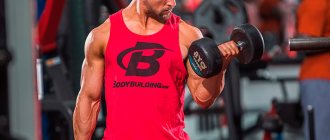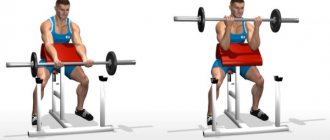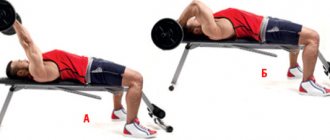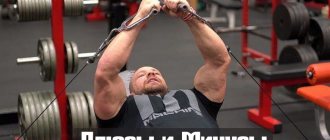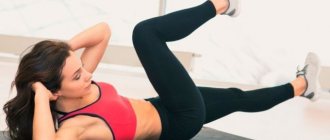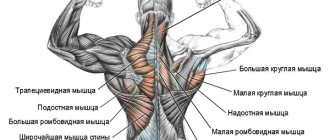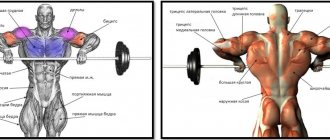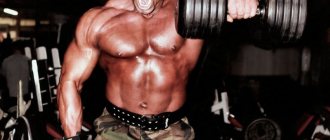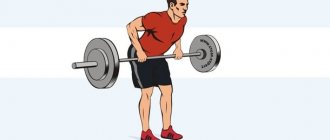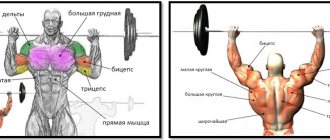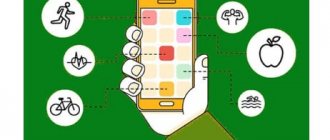Standing barbell curls are the main exercise for training the biceps muscles. The muscles of the forearm and the anterior deltas of the shoulders assist in the work. The barbell curl is considered an isolation movement, but can be performed as a compound exercise. When the elbows, at the expense of the shoulders, rise slightly upward.
The target muscles for work are the biceps.
Alternative (similar) exercises:
- Standing dumbbell curls for biceps.
- Cable biceps curl.
- Lifting dumbbells while sitting.
What muscles are involved?
In this exercise, whether you do it standing or sitting, with dumbbells or a barbell with a straight or curved bar, slightly different muscle groups will work to varying degrees in the grip position:
- Overhand grip (palms facing down) – the brachial and brachioradialis muscle groups will be involved.
- Reverse grip (palms facing up) – loads the brachialis muscle and the biceps brachii itself.
In addition, the work will include the brachialis, extensor carpi and anterior delta.
Bottom line
A set of exercises for developing shoulder muscles should include all the exercises described above, since they all have different effects on muscle development and place stress on one or another muscle group. And curling the arms with a barbell with a standing reverse grip, and with dumbbells, and a narrow grip, the hammer exercise - all this allows you to supplement and improve the quality load on the shoulder muscles.
Just remember that if you have any shoulder or forearm injuries, consult your doctor before starting any exercises.
Correct technique
Technique:
- Starting position – back straight, legs shoulder-width apart, feet parallel, toes slightly apart. Grab the bar with an underhand grip (palms facing up). The spine is in a neutral position, do not strain the shoulder girdle.
- As you inhale, slowly, without jerking, lift the barbell until your forearms are vertical. Do not press your elbows to your body or spread them to the sides. Lift weights using your biceps only. You cannot use inertia, wrists, bend your back, or help yourself with your torso. During a short pause at the top, turn up the heat with even more muscle tension.
- Exhale as you lower the barbell down, straightening your arms completely. The body remains motionless.
Note:
- During execution, you cannot raise or pull your shoulders back. There is a risk of injury to the spine. In addition, a significant part of the required load is removed.
- If your elbows are not locked in the correct position and are flopping around during the press, you will not reach the peak of the contraction. The load on the main muscle will be weakened.
- Select the optimal projectile weight. If it's too heavy, you'll be forced to push it with your hips first. This is absolutely not what is needed. In addition, you risk injuring your lower back. Excess weight limits the range of movement. And to build muscle, it is important to stretch it at the bottom to the fullest. It makes sense not to fully straighten your arms below if the goal is to increase the peak of your biceps.
Help and insurance
Poor technique in arm curls results in the torso tilting back and the elbows moving forward. As soon as your torso begins to deviate from the vertical, you immediately need to straighten up and start paying more attention to your technique. But to complete the next repetition with good technique, you will need a little input from your partner. The assistant should grasp the bar with both hands, symmetrically. Assistance should be given as much as necessary to maintain the torso and upper arms in an upright position.
As noted above, if you perform arm curls on a bench for “prayer,” then having an assistant is a must.
Possible options
What muscles work with different variations of this exercise:
- if the grip is palms up, the biceps and shoulder work, their volume increases;
- with a reverse grip (palms down), the shoulder and forearm are intensively loaded. This position is for raising the peak;
- The tension sight changes depending on the working width. For example, a grip that is wider than shoulder width will engage the inside of the biceps muscle. The execution rules are the same. But be careful - you may experience pain in your elbows;
- if you use a Z-bar, it works the biceps even more, but the load is removed from the forearm - in this case, it is important to grip the bar from below, the thumb should be higher than the little finger.
So, when performing this exercise, we will use the following areas of the body:
- biceps;
- brachioradialis muscle;
- forearm;
- elbow joint.
How to train
Beginning bodybuilders should train three times a week. For muscles to grow, they must recover. Train your biceps once a week. As you progress, you can switch to 2-time double-headed training.
Gradually add the weight of the barbell and the number of flexions and extensions.
Remember: to pump up muscles and create relief, you need a large number of repetitions and exercise through strength. Do several approaches with the optimal number of presses for you.
Girls rule too
The biceps curl is also suitable for girls, but the execution has some minor nuances.
- Stand up straight, grab the bar with a palms down grip, place your hands shoulder-width apart. Bend your legs slightly. Elbows - strictly on the sides. Don't tense your shoulders and spine.
- Slowly, while inhaling, without jerking, bending your elbows, lift the projectile to your chest as far as you can. Don't arch your lower back.
- As you exhale, slowly lower the weight down using the strength of the biceps muscle, rather than dropping it by inertia. The heels do not come off the floor.
Reverse grip biceps curl
This exercise, in addition to the biceps and flexor muscles, also uses the forearms. The weight in this exercise should be less than in regular barbell curls.
This is due to the fact that with such a grip it is more difficult to hold the barbell in your hands. It is recommended for athletes who already have experience in bodybuilding, as well as professionals. The most appropriate time would be the end of the workout.
Once you've loaded your forearms with this exercise, it's wise to follow it up with wrist curls using dumbbells or a barbell to finish them off. A hand expander is also perfect for this purpose.
Execution technique
To begin with, before performing, take the correct starting position. Stand straight with your feet shoulder-width apart, with your knees slightly bent for greater stability. Put your chest forward, straighten your back completely and bend at the lower back. Take the bar with an overhand grip and lower it down with almost straight arms. The distance between the palms is equal to the width of the shoulders.
Taking a deep breath, lift the bar toward your chest while keeping your elbows close to your sides. It is very important that only the lower arms move.
Exhale at the top, stop, while strongly contracting your muscles. After this, smoothly return the bar to the lowest point. Then proceed to the next repetition.
Recommendations
- Don't use too much weight. This may affect the correct execution of the exercise. A heavy barbell at the bottom will force you to push it out with your whole body, this should not be allowed.
- Remember that only the lower arms move in this exercise. Try to keep your wrists in line with your forearms at all times.
- This exercise can also be performed by replacing the barbell with dumbbells. But still, the first option gives the best results, since using dumbbells you will begin to turn your wrists and reduce the load on your forearms.
- In this exercise, the shoulder muscle takes the main load, not the biceps. Therefore, the weight should be lighter than when lifting with an underhand grip.
- If you feel that your forearms are stronger, then you can increase the load you use.
The reverse grip biceps curl pumps up the brachialis and brachialis radialis muscles, as well as the biceps brachii muscle. Perform approximately 3-4 sets, each with 10-15 repetitions.
Common mistakes
In most people, the right and left hands are developed unevenly. For this reason, many beginners try to pull the barbell using the strength of one arm. In no case should you do this, because the biceps of a stronger and more active arm will be worked out better and will gain mass faster. This will lead to asymmetry in the future.
Some athletes curl their wrists too much when they try to lift too much weight. It is important to remember that the hands should be in a natural position at all times. If you start to feel a lot of tension, it means your grip is incorrect or you are bending your wrists too much at the top of the range.
Sometimes you can observe a mistake that consists of lifting the barbell too high . Because of this, the load on the biceps at the top point is significantly reduced. To prevent this from happening, you don’t need to push the barbell all the way.
Contraindications
- Hernias (lumbar) – Avoid standing barbell curls and use strict lighter wall curls or seated dumbbell curls.
- Inflammation of the ligaments (muscles) of the elbow and shoulder joints - avoid this exercise. Give your muscles a rest for 3-5 days or lower the weights until they are fully restored.
- Injuries to the elbows, wrists, shoulder joints, lower back - I do not recommend performing this exercise with heavy weights. In this case, it is better to reduce the weight, but do more repetitions per set.
- Use hand wraps if your arm muscles are already overloaded.
Sport and health
One of the most common questions in athletics. What develops biceps better, barbell or dumbbells? But in reality, the correct answer here is not to figure out which is better, but to figure out how to more effectively combine these two types of training. In fact, both dumbbells and barbells are equally effective for biceps, but they develop and work them in their own way. Therefore, in hand training you need to use both.
The barbell is best suited for basic strength work on the total mass of the biceps, while dumbbells allow for focused training to increase the peak of the biceps or develop the brachialis and forearms. By the way, it is the hypertrophied brachialis that can literally push the biceps out, which is why it will look visually larger. The EZ barbell variation also puts a slight emphasis on the brachialis and forearms, but the hammer style dumbbell lifts still hit these muscles 100%.
The barbell is usually number one in arm training, followed by dumbbells. But this order is not at all mandatory. Periodically, in order to “surprise” the muscles, you need to change the order of the exercises and first perform dumbbell lifts while standing or sitting, and then the barbell. This technique can have another positive effect: after lifting dumbbells, the biceps will be sufficiently tired and when you move on to the barbell, they will “respond”
an unbearable burning sensation, and very quickly. Efficiency will increase. At the same time, the weight of the bar should no longer be large, which will have a positive effect on the technique of execution, without cheating and jerking.
Negative repetitions, when a heavy weight is slowly and controlledly lowered to the lowest point of the amplitude, are best performed with a barbell, since a uniform synchronous load is achieved here. This technique can be extremely effective for increasing the strength and overall mass of the biceps, but should only be performed by advanced athletes with developed muscles and strong ligaments. For beginners, regular barbell lifts in combination with dumbbells are best suited.
A characteristic effective feature of dumbbell lifts is the possibility of supination and pronation of the hand during lifting. (supination is the maximum turn of the hand with the palm up, pronation is the turn of the hand when the palms are parallel to each other or “look” down). If you lift the dumbbells (alternately or together) with maximum supination, there will be an emphasis on increasing the peak of the biceps, which creates a spectacular look. If you lift dumbbells with the hand pronated, then the main load will go to the brachialis and forearms, while the biceps itself will develop in width. Hammer style dumbbell raises are great for developing arm strength. When you regularly perform the “hammer”, the working weights in barbell lifting and other exercises with dumbbells increase.
Exercises with dumbbells are quite varied. If you want to do real strength work with a solid weight, then the best choice is standing dumbbell curls, where you can use a small cheat in the final reps, but if you want to feel the biceps as best as possible and achieve a burn in them (which means their subsequent growth), then lifting dumbbells on an inclined bench at an angle of 30-45 degrees (with supination) is most suitable.
One of the most effective devices for training biceps is the Scott bench, which was invented by 2-time Mr. Olympia Larry Scott. Although he himself initially called his invention a music stand, later everyone began to call the bench in honor of its creator. The Scott bench allows you to train with both a barbell and dumbbells, achieving simply incredible results. Larry Scott himself used a triple variation here, lifting first dumbbells, then a barbell with palms up, and then an EZ barbell with palms down. As the champion himself later said, this technique made his biceps record-breakingly developed for its time.
Biceps training (once a week):
1. Standing barbell (EZ-bar) curl: 3 sets, 8-10 reps
2. Standing (seated) dumbbell curls for biceps: 3 sets, 8-12 reps
3. Concentrated dumbbell curls while seated: 3 sets, 10-12 reps.
In contact with
LiveJournal
What else will help pump up your biceps?
- The main exercise for our dream muscles is the close-grip pull-up. The back, shoulder joints, and elbows are also included.
- Another basic exercise is the standing dumbbell press. Raising your arms up, we turn your hands outward, which makes it possible to increase the load.
- Biceps curls while sitting on a machine work out the lower part of the biceps. Suitable for intermediate and advanced bodybuilders. To avoid joint injuries, it is important to adjust the machine to suit you in advance.
- Lifting dumbbells with emphasis on the thigh is popular when preparing for competitions - it forms the peak of the muscle well.
- A cable trainer will help you work out the desired area using a block row while standing. The latissimus dorsi muscle is also involved.
By alternating all types of exercises you can achieve truly outstanding results, believe me.
